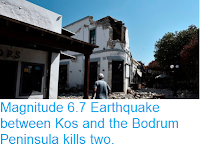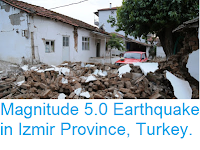The United States Geological Survey recorded
a Magnitude 4.8 Earthquake at a depth of 29.8 km, about 15 km to the northeast of the town of Akseki in Antalya Province, Turkey, slightly before 8.15 pm local time
(slightly before 5.15
pm GMT) on Friday 13 April 2018. No damage or injuries have been
reported following this event, but people have reported feeling the
event locally.
The approximate location of the 13 April 2018 Akseki Province Earthquake. USGS.
Akseki Province lies on the boundary between the Anatolian Plate,
to the north, the Aegean Sea Plate (underlying
the Peloponnese, Attica, The Cyclades Islands, Crete, the Dodecanese
Islands and Turkey to the southeast of the Taurus Mountains) to the west and the African Plate to the south. Northern Greece
and the north coast of Turkey lie on the Eurasian Plate. Both countries
are highly prone to earthquakes because of this.
To the east the Arabian Plate is being pushed north and west by the movement of the African Plate, further to the south. This leads to a zone of tectonic activity within the province, as the Arabian and Anatolian plates are pushed together, along the East Anatolian Fault, and past one-another, along the Dead Sea Transform.
This movement also leads to a zone of faulting along the northern part of Turkey, the North Anatolian Fault Zone, as the Anatolian Plate is pushed past the Eurasian Plate, which underlies the Black Sea and Crimean Peninsula (transform faulting). This is not a simple process, as the two plates constantly stick together, then break apart as the pressure builds up, leading to Earthquakes, which can be some distance from the actual fault zone.
Witness
accounts of Earthquakes can help geologists to understand these events,
and the structures that cause them. The international non-profit
organisation Earthquake Report is interested in hearing from people who may have felt this event; if you felt this quake then you can report it to Earthquake Report here.
See also...
Follow Sciency Thoughts on Facebook.








